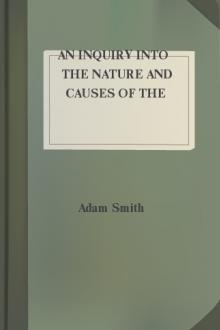The Wealth of Nations by Adam Smith (the best motivational books .TXT) 📕

- Author: Adam Smith
Book online «The Wealth of Nations by Adam Smith (the best motivational books .TXT) 📕». Author Adam Smith
Chronicon Rusticum-Commerciale; or Memoirs of Wool, etc., 1767, vol. ii, p. 418, note. ↩
Above, here. ↩
Additions and Corrections reads “the wool.” ↩
12 Car. II, c. 32; 13 and 14 Car. II, c. 18. ↩
13 and 14 Car. II, c. 18, § 8. The preamble to the clause alleges that “great quantities of fuller’s earth or fulling clay are daily carried and exported under the colour of tobacco-pipe clay.” ↩
The preamble says that “notwithstanding the many good laws before this time made and still in force, prohibiting the exportation of leather … by the cunning and subtlety of some persons and the neglect of others who ought to take care thereof; there are such quantities of leather daily exported to foreign parts that the price of leather is grown to those excessive rates that many artificers working leather cannot furnish themselves with sufficient store thereof for the carrying on of their trades, and the poor sort of people are not able to buy those things made of leather which of necessity they must make use of.” ↩
20 Car. II, c. 5; 9 Ann., c. 6, § 4. ↩
9 Ann., c. 11, § 39, explained by 10 Ann., c. 26, § 6, and 12 Ann., st. 2, c. 9, § 64. ↩
Above, here. ↩
Except under certain conditions by 4 Ed. IV, c. 8; wholly by 7 Jac. I, c. 14, § 4. ↩
Under 13 and 14 Car. II, c. 18, and 7 and 8 W. III, c. 28; above, p. 147. ↩
See below, here. ↩
9 and 10 W. III, c. 28, professedly to prevent frauds. ↩
The preamble to the Act next quoted in the text mentions 28 Ed. III, c. 5 (iron); 33 Hen. VIII, c. 7 (brass, copper, etc.), and 2 and 3 Ed. VI, c. 37 (bell-metal, etc.). ↩
This Act is not printed in the ordinary collections, but the provision referred to is in Pickering’s index, s.v. Copper, and the clause is recited in a renewing Act, 12 Ann., st. 1, c. 18. ↩
Under the general Act, 8 Geo. I, c. 15, mentioned immediately below. ↩
12 Car. II, c. 4, § 2, and 14 Car. II, c. 11, § 35. The 1 percent was due on goods exported to ports in the Mediterranean beyond Malaga, unless the ship had sixteen guns and other warlike equipment. See Saxby, British Customs, pp. 48, 51. ↩
Sixpence in the pound on the values at which they are rated in the Act. ↩
C. 32. ↩
Anderson, Commerce, AD 1758. ↩
As is stated in the preamble. ↩
The facts are given in the preamble to 8 Geo. I, c. 15, § 13. The old subsidy, the new, the one-third and the two-thirds subsidies account for 1s., and the additional impost for 4d. ↩
See above, here. ↩
8 Geo. I, c. 15. —Smith
The year should be 1721. —Cannan ↩
I.e. the hatters. ↩
4 Geo. III, c. 9. ↩
Under the same statute, 5 Geo. I, c. 27. ↩
Above, here. ↩
This chapter appears first in Additions and Corrections and ed. 3, and is doubtless largely due to Smith’s appointment in 1778 to the Commissionership of Customs (Rae, Life of Adam Smith, p. 320). He had in his library W. Sims and R. Frewin, The Rates of Merchandise, 1782 (see Bonar, Catalogue, p. 27), and probably had access to earlier works, such as Saxby’s British Customs, 1757, which give the duties, etc., at earlier periods as well as references to the Acts of Parliament regulating them. ↩
The Économistes or Physiocrats. Quesnay, Mirabeau and Mercier de la Rivière are mentioned below, pp. 171, 177. ↩
Ed. 1 places a full stop at “mercantile system” and continues “That system, in its nature and essence a system of restraint and regulation, could scarce fail.” ↩
But, see below, here, where the usefulness of the class is said to be admitted. In his exposition of physiocratic doctrine, Smith does not appear to follow any particular book closely. His library contained Du Pont’s Physiocratie, ou constitution naturelle du gouvernement le plus avantageux au genre humain, 1768 (see Bonar, Catalogue, p. 92), and he refers lower down to La Rivière, L’ordre naturel et essentiel des sociétés politiques, 1767, but he probably relied largely on his recollection of conversations in Paris; see Rae, Life of Adam Smith, pp. 215–222. ↩
Ed. 1 reads “tear and wear.” ↩
Ed. 1 reads “some other employment.” ↩
Ed. 1 reads “degrades.” ↩
Ed. 1 reads “repay him.” ↩
Ed. 1 reads “above the funds destined.” ↩
Ed. 1 reads “the greater must likewise be its maintenance and employment.” ↩
Misprinted “greater” in ed. 5. ↩
Ed. 1 reads “of their foreign trade.” ↩
See François Quesnay, Tableau Œconomique, 1758, reproduced in facsimile for the British Economic Association, 1894. ↩
Ed. 1 reads “at least to all appearance.” ↩
This chapter. ↩
See





Comments (0)